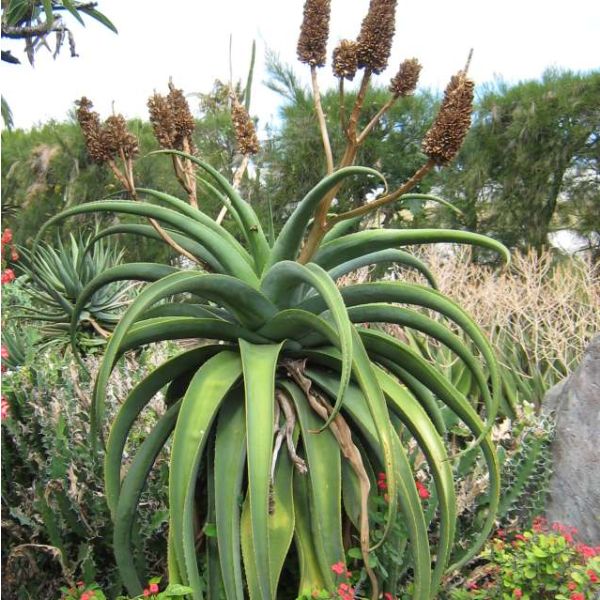Aloe Vaombe Seeds (Madagascar or Malagasy Tree Aloe Seeds)
Aloe Vaombe Seeds (Madagascar or Malagasy Tree Aloe Seeds)
Striking Madagascar-native succulent with thick, rosette leaves and tall flower spikes adorned with tubular orange-red blooms.

Delivery
All orders shipped with UPS Express.
Always free shipping for orders over US $250.
All orders are shipped with a UPS tracking number.
Returns
Items returned within 14 days of their original shipment date in same as new condition will be eligible for a full refund or store credit.
Refunds will be charged back to the original form of payment used for purchase.
Customer is responsible for shipping charges when making returns and shipping/handling fees of original purchase is non-refundable.
All sale items are final purchases.
Help
Give us a shout if you have any other questions and/or concerns.
Email: contact@domain.com
Phone: +1 (23) 456 789
Availability: In stock
SKU
Aloe Vaombe
Aloe Vaombe is a succulent of the genus Aloe in the subfamily of Asphodeloideae. It is native to Southern Madagascar (Toliara Province). This evergreen plant has long smooth green leaves with whitish teeth and bright crimson flowers that blooms in June-July in Madagascar. Aloe Vaombe can make a beautiful centerpiece specimen for a garden. It can reach up to 12 feet (3,6 m) tall or more.
Aloe Vaombe is drought-tolerant and frost-tolerant (0øC) but can be badly damaged if it gets colder. It handles most soil types and variety of climates. It needs full sun in general and doesn?t require a lot of water.
The plant is harvested from the wild for local medicinal use.
Hardiness zone: 10-12
| Label | Aloe vaombe |
|---|---|
| Common name | Madagascar Tree Aloe, Malagasy Tree Aloe |
| Family | Xanthorrhoeaceae |
| Genus | Aloe |
| Species | Aloe vaombe |
| Therapeutic uses | Aloe Vaombe is a succulent of the genus Aloe in the subfamily of Asphodeloideae. It is native to Southern Madagascar (Toliara Province). This evergreen plant has long smooth green leaves with whitish teeth and bright crimson flowers that blooms in June-July in Madagascar. Aloe Vaombe can make a beautiful centerpiece specimen for a garden. It can reach up to 12 feet (3,6 m) tall or more. Aloe Vaombe is drought-tolerant and frost-tolerant (0øC) but can be badly damaged if it gets colder. It handles most soil types and variety of climates. It needs full sun in general and doesn?t require a lot of water. The plant is harvested from the wild for local medicinal use. Hardiness zone: 10-12 The sap of Aloe species contains anthraquinones. These compounds have several beneficial medicinal actions, particularly as a laxative. Anthraquinones do have potential problems if used in excess. These include congestion and irritation of the pelvic organs. An infusion of the leaves is used as a treatment of yellow fever. Also, the leaf juice is applied externally to treat skin lesions. In another test, administration of a gel extract called ?Alva? reduced the growth rate of fibrosarcoma and melanoma tumours. |
| Germination | Combine 2 parts sand, 1 part perlite and 1 part sterile compost in a bucket. Stir the components while adding water. Add water and stir until the mixture feels moderately moist and takes on a uniform appearance. Pack the sand mixture into a 2-inch-deep nursery flat. Fill it to within 1/4 inch of the top. Press the surface to make it even and squeeze out any trapped air. Lay out the aloe seeds 1 inch apart on the surface of the sand mixture. Push the seeds into the surface of the mixture with the flat of your hand. Cover the seeds with a very thin layer of sand. Place the nursery flat on a large table or workbench where it will receive eight to 10 hours of sunlight daily. Shine a fluorescent lamp onto the nursery flat for eight to 10 hours daily if sufficient natural light is unavailable. Warm the bottom of the nursery tray with a heat mat set to 70 F. Keep the heat mat turned on at all times while the seeds germinate. Drape a sheet of plastic wrap over the nursery tray to help hold in the warmth. Remove the plastic wrap for a few hours to dispel trapped moisture whenever excess condensation forms inside. Mist the aloe seeds whenever the sand mixture dries out in the top 1/2 inch. Avoid letting the sand dry out completely for longer than six to eight hours, but do not saturate it either. Look for sprouts in two to four weeks, depending on the species of aloe. Keep the nursery flat on the heat mat for two weeks after germination. Water by drizzling water carefully around each sprout instead of misting the seedlings with water, which can precipitate a fungal infection. Transplant the aloe seedlings into individual 2-inch pots filled with the same growing mixture you created initially. Scoop the seedlings from the nursery flat using a spoon and transfer them into the pots. Water them with 1 tablespoon of water every three days. |
| Price View | Price Range |

